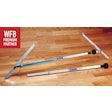Q: Do you have any tips for installing prefinished flooring?
A: Throughout my many years in the flooring industry (as installer, store owner, trainer, consultant), I have never known an installer who decided ahead of time to screw up a job. However, I have known installers who were unable to attend training because they were too busy replacing a job—for the third time (true story)! I suggest this may be poor judgment …
Good installers will continue to learn throughout their careers as technology brings new products and tools to the marketplace. Installers, training and product knowledge are your friends. When an installer picks up his nail gun or trowel, he is saying, "I am a professional. I have read the manufacturer's installation instructions, and I have the knowledge and skill to ensure a successful installation. I take full responsibility for knowing this is the proper wood for the location; my layout is correct; I have an acceptable subfloor; I have checked all moisture levels; I know the correct nailing pattern and have the correct nailer (or adhesive and trowel); and I have checked the wood to make sure it is free of visible manufacturing defects. I am qualified to install this floor."
Aluminum Oxide
All wood floors are not created equal, and contrary to the old cliché, what we don't know can (and will) hurt us. In the prefinished hardwood flooring arena, there's a relatively new player on the floor who is commanding a certain amount of respect—his name is aluminum oxide. This finish is proving to be a lifelong friend to the consumer and a new challenge for the installer.
Aluminum oxide, second to diamond in hardness, is being added to finishes at various levels to increase durability; however, it can fracture at the edge when it makes contact with a steel nailer or mallet. The traditional UV-cured urethane finishes are much more forgiving than the harder aluminumoxide finishes. From the top, aluminum oxide is tough; from the edge, it is vulnerable. A special adapter shoe on your nailer is the only way to prevent fracturing of aluminum-oxide finish. If you are experiencing edge damage when installing products with this finish, I can almost guarantee you are not using this adapter shoe. This shoe is not the adapter that comes with the nailer. It is an additional attachment specific to your brand of nailer and is available from your nailer's manufacturer.
Installation Tips
Here are a few installation tips that I share at training events across the country:
• When laying out a floor, know where you are going before you get there, so when you get there, there are no surprises.
• Moisture meters are not an option—they are a necessity. Take readings in several areas throughout the subfloor. These readings can even be recorded on the subfloor as proof, if ever needed.
For nail-down:
• Remember that different thicknesses of wood require different shoes on the nailer.
• Regulators for the compressor and the nailer are essential installation tools. Cleats or staples are equally acceptable fasteners; however, nailing patterns vary, and the proper psi is critical. Too many fasteners will break the tongue, and too much pressure will blow the fastener through the tongue, both resulting is loss of holding power. Too few fasteners also results in loss of holding power, and pressure that's too low sets the fastener too high on the tongue, resulting in surface pimpling.
For glue-down:
• A trowel is a measuring device as well as a spreader. Be sure to hold the trowel at the angle recommended by the adhesive manufacturer to ensure the correct spread rate. Some manufacturers recommend holding the trowel at a 45-degree angle, while others recommend 90 degrees. Also, be sure to always use a trowel with the notch pattern recommended by the glue manufacturer.
• Always place the tongue into the groove, then drop the board onto the glue and tighten. Glue has a memory: If the groove is pushed onto the tongue, your boards will want to retract, leaving a hairline crack.
• Use blue release tape recommended by the flooring manufacturer to hold boards together until the glue grabs. Don't leave the tape on overnight.
The finishing touch:
- Use boards that have similar color and shading next to trim pieces.
- Using filler and performing final clean-up with a floor cleaner both add final touches to a professional installation.
































